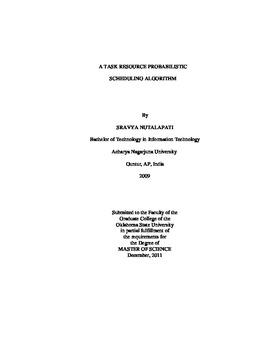| dc.contributor.advisor | Thomas, Johnson P. | |
| dc.contributor.author | Nutalapati, Sravya | |
| dc.date.accessioned | 2014-04-15T18:33:06Z | |
| dc.date.available | 2014-04-15T18:33:06Z | |
| dc.date.issued | 2011-12-01 | |
| dc.identifier.uri | https://hdl.handle.net/11244/8215 | |
| dc.description.abstract | The future of mobile health monitoring combined with cloud computing is expected to see a lot of technological advances. In this thesis we assume that to remotely monitor a patient, biomedical sensors are attached to the patient's body. The signals from the sensors of different patients are sent over to a six filter system through the patient's cell phone. The filter is located between a geographical group of patients and the cloud. The filter will measure, analyze and process the sensor data such as temperature, blood pressure, heart beat, etc. If timely action is required, the data is sent to the hospital management system and a copy of the data will be stored in the cloud. The parameters which do not require a real-time response are sent over to the cloud. e proposed scheduling algorithm is validated using CloudSim, which is a tool kit for modeling and simulation of cloud computing environments. The scheduling algorithm, which runs on the filters, schedules the tasks arriving from different patients, based on the resources available in the cloud. The scheduling algorithm ensures that time constrained tasks get scheduled and executed before the deadline. The tasks which are not time constrained are scheduled on any one of the filters based on a probabilistic function. Simulation results of the scheduling algorithm show that with an increase in the average number of tasks at a filter, the percentage of tasks that will meet the deadline decrease. Furthermore, with an increase in the deadline of tasks, the percentage of tasks that will meet the deadline also increases. As non-emergency tasks do not have a time constraint, they will always find a filter to execute. Future work will seek to improve on the above approach in order to effectively schedule emergency situations and also identify approaches to place the filters in appropriate locations to optimize performance. | |
| dc.format | application/pdf | |
| dc.language | en_US | |
| dc.publisher | Oklahoma State University | |
| dc.rights | Copyright is held by the author who has granted the Oklahoma State University Library the non-exclusive right to share this material in its institutional repository. Contact Digital Library Services at lib-dls@okstate.edu or 405-744-9161 for the permission policy on the use, reproduction or distribution of this material. | |
| dc.title | Task Resource Probabilistic Scheduling Algorithm | |
| dc.type | text | |
| dc.contributor.committeeMember | Kak, Subhash C. | |
| dc.contributor.committeeMember | Toulouse, Michel | |
| osu.filename | Nutalapati_okstate_0664M_11853.pdf | |
| osu.college | Arts and Sciences | |
| osu.accesstype | Open Access | |
| dc.description.department | Computer Science Department | |
| dc.type.genre | Thesis | |
| dc.subject.keywords | computer science | |
